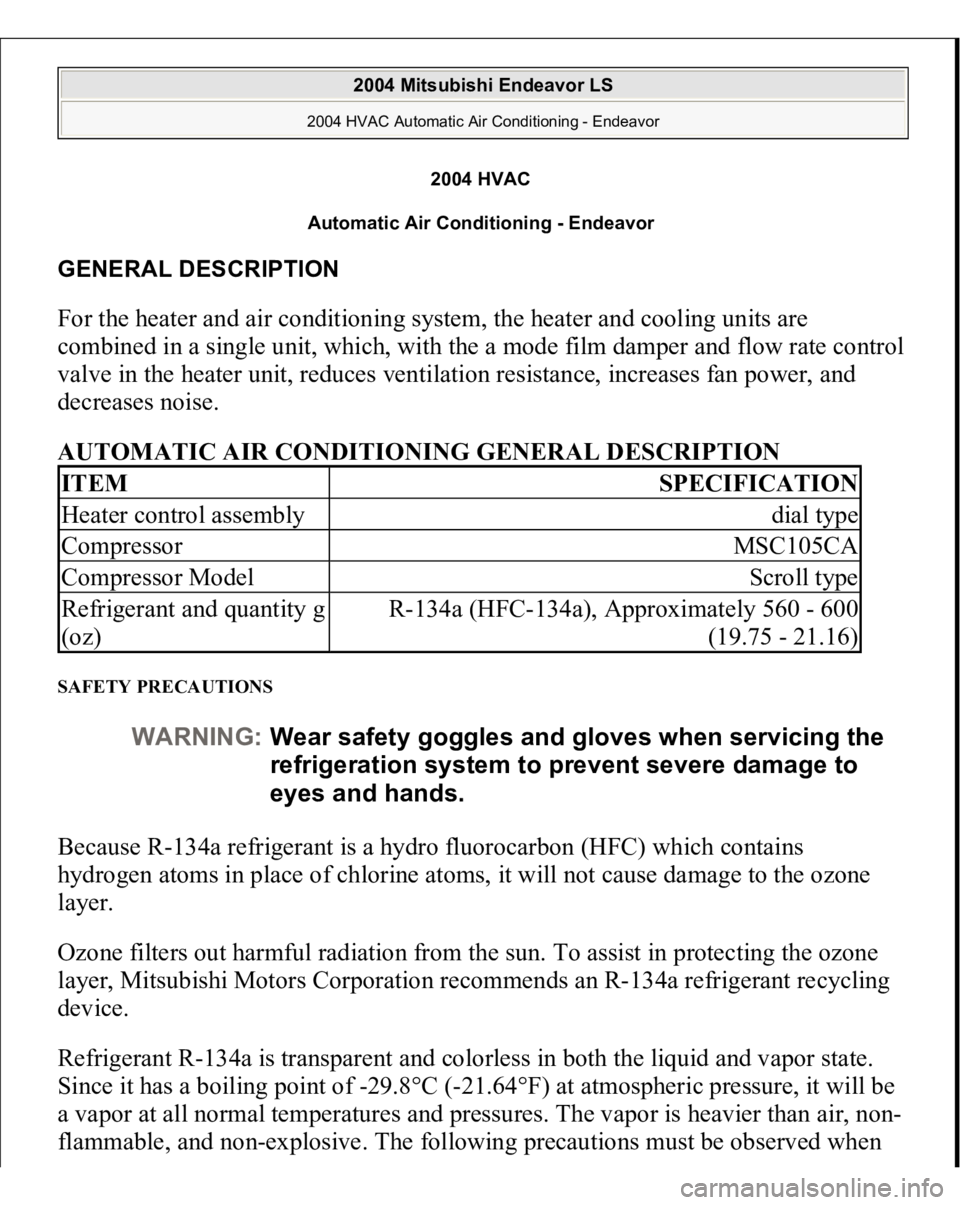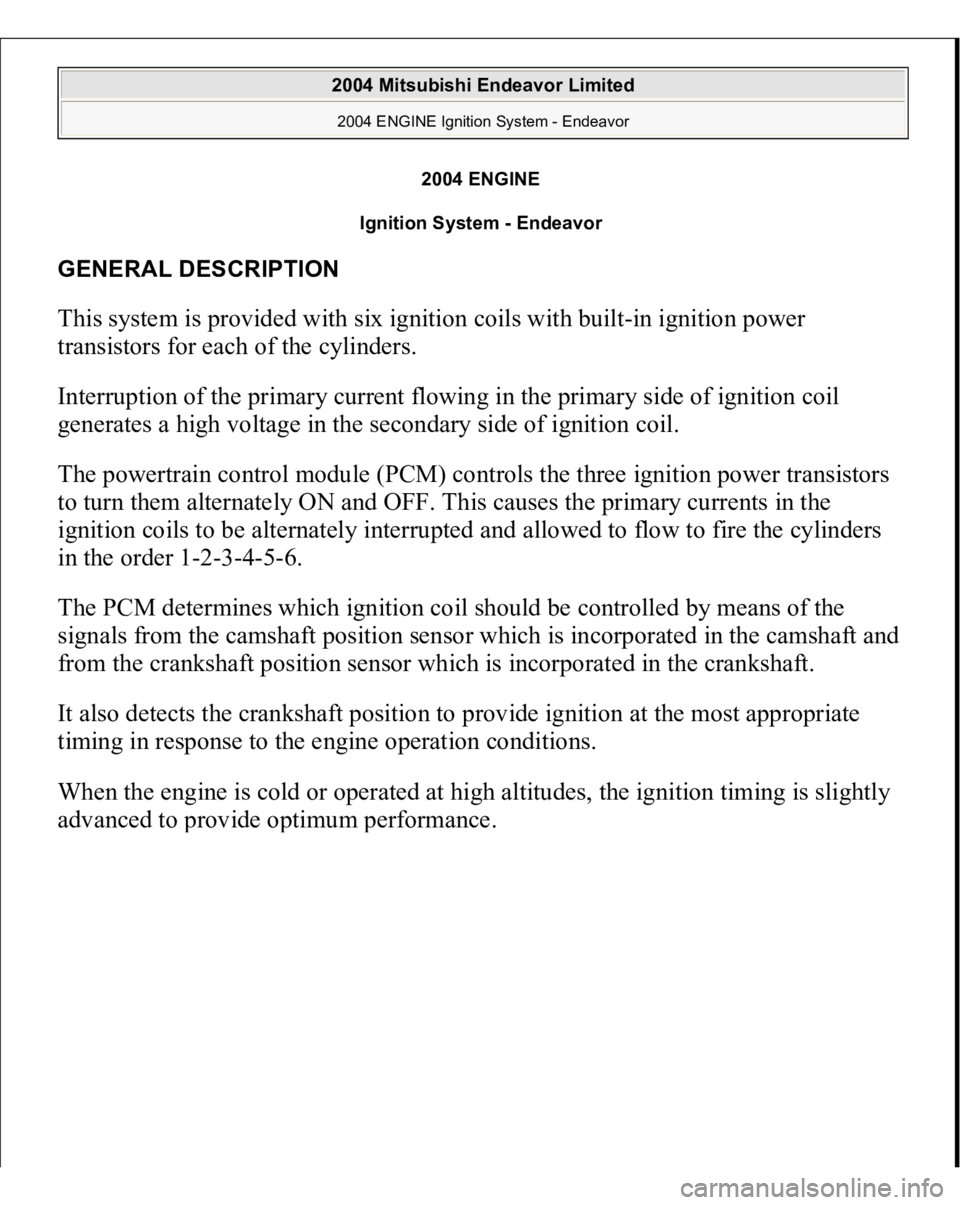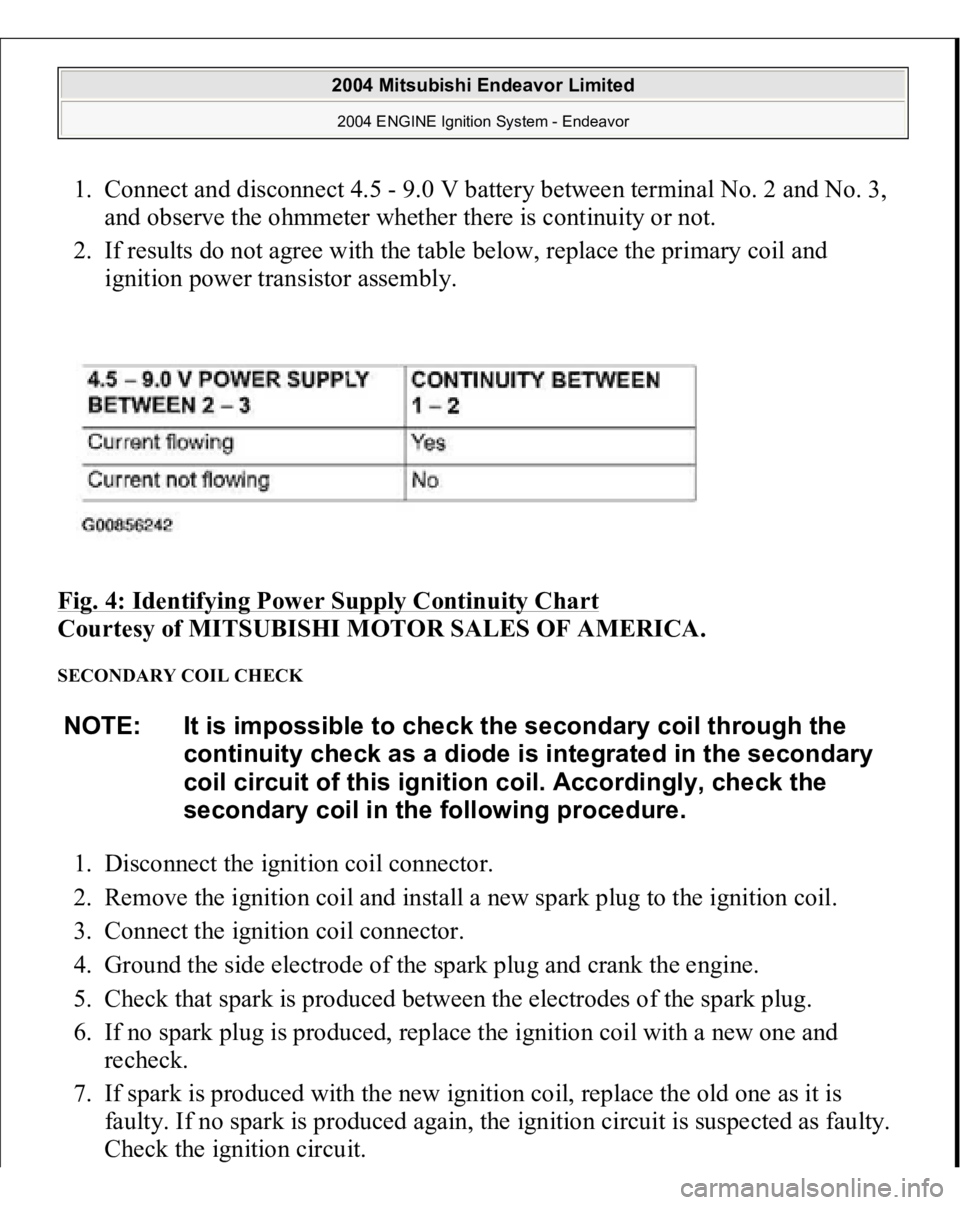Page 2412 of 3870
Fig. 310: Removing And Installing Refrigerant Line
Courtesy of MITSUBISHI MOTOR SALES OF AMERICA.
REMOVAL SERVICE POINT << A >> HOSE/PIPE DISCONNECTION To prevent the entry of other foreign bodies, plug the condenser, compressor, and
expansion valve nipples. << B >> SUCTION PIPE AND SUCTION FLEXIBLE HOSE DISCONNECTION
CAUTION: As the compressor oil and receiver are highly
moisture absorbent, use a non-porous material to
plug the hose and nipples.
CAUTION: As the compressor oil and receiver are highly
2004 Mitsubishi Endeavor LS
2004 HVAC Heater Air Conditioning, Ventilation - Endeavor
Page 2413 of 3870
To disconnect the suction hose from the suction flexible hose, lift the lug on the
suction pipe and twist the suction flexible hose union counterclockwise.
Plug the hose nipple to prevent entry of dust and dirt. Fig. 311: Disconnecting Suction Pipe
Courtesy of MITSUBISHI MOTOR SALES OF AMERICA.
INSTALLATION SERVICE POINT >> A << SUCTION HOSE INSTALLATION When replacing the suction hose, refill them with a specified amount of compressor
oil, and then install them.
moisture absorbent, use a non-porous material to
plug the hose and nipples.
2004 Mitsubishi Endeavor LS
2004 HVAC Heater Air Conditioning, Ventilation - Endeavor
Page 2414 of 3870
Compressor oil: SUN PAG 56
Quantity:
Suction hose:
10 cm
3 (0.3 fl.oz)
VENTILATORS REMOVAL AND INSTALLATION
2004 Mitsubishi Endeavor LS
2004 HVAC Heater Air Conditioning, Ventilation - Endeavor
Page 2419 of 3870

2004 HVAC
Automatic Air Conditioning - Endeavor
GENERAL DESCRIPTION For the heater and air conditioning system, the heater and cooling units are
combined in a single unit, which, with the a mode film damper and flow rate control
valve in the heater unit, reduces ventilation resistance, increases fan power, and
decreases noise. AUTOMATIC AIR CONDITIONING GENERAL DESCRIPTION
SAFETY PRECAUTIONS Because R-134a refrigerant is a hydro fluorocarbon (HFC) which contains
hydrogen atoms in place of chlorine atoms, it will not cause damage to the ozone
layer.
Ozone filters out harmful radiation from the sun. To assist in protecting the ozone
layer, Mitsubishi Motors Corporation recommends an R-134a refrigerant recycling
device.
Refrigerant R-134a is transparent and colorless in both the liquid and vapor state.
Since it has a boiling point of -29.8°C (-21.64°F) at atmospheric pressure, it will be
a vapor at all normal temperatures and pressures. The vapor is heavier than air, non-
flammable, and no
n-ex
plosive. The followin
g precautions must be observed when
ITEM
SPECIFICATION
Heater control assembly
dial type
Compressor
MSC105CA
Compressor Model
Scroll type
Refrigerant and quantity g
(oz)
R-134a (HFC-134a), Approximately 560 - 600
(19.75 - 21.16)
WARNING:Wear safety goggles and gloves when servicing the
refrigeration system to prevent severe damage to
eyes and hands.
2004 Mitsubishi Endeavor LS
2004 HVAC Automatic Air Conditioning - Endeavor
2004 Mitsubishi Endeavor LS
2004 HVAC Automatic Air Conditioning - Endeavor
Page 2420 of 3870

handling R-134a.
R-134a evaporates so rapidly at normal atmospheric pressures and temperatures that
it tends to freeze anything it contacts. For this reason, extreme care must be taken to
prevent any liquid refrigerant from contacting the skin and especially the eyes.
Always wear safety goggles when servicing the refrigeration part of the A/C
system. Keep a bottle of sterile mineral oil handy when working on the refrigeration
system.
1. Should any liquid refrigerant get into your eyes, use a few drops of mineral oil
to wash them out.
R-134a is rapidly absorbed by the oil.
2. Next splash your eyes with plenty of cold water.
3. Call your doctor immediately even if irritation has ceased.
In most instances, moderate heat is required to bring the pressure of the refrigerant
in its container above the pressure of the system when charging or adding
refrigerant.
A bucket or large pan of hot water not over 40°C (104.0°F) is all the heat required
for this purpose. Do not heat the refrigerant container with a blow torch or any other
means that would raise temperature and pressure above this temperature. Do not
weld or steam-clean on or near the system components or refrigerant lines.
WARNING:Do not heat R-134a above 40 °C (104.0 °F) or it may
catch fire and explode.
CAUTION: Keep R-134a containers upright when charging the
system.
WARNING:The leak detector for R-134a should be used to
check for refrigerant gas leaks.
CAUTION: Do not allow liquid refrigerant to touch bright metal
2004 Mitsubishi Endeavor LS
2004 HVAC Automatic Air Conditioning - Endeavor
Page 2683 of 3870

2004 ENGINE
Ignition System - Endeavor
GENERAL DESCRIPTION This system is provided with six ignition coils with built-in ignition power
transistors for each of the cylinders.
Interruption of the primary current flowing in the primary side of ignition coil
generates a high voltage in the secondary side of ignition coil.
The powertrain control module (PCM) controls the three ignition power transistors
to turn them alternately ON and OFF. This causes the primary currents in the
ignition coils to be alternately interrupted and allowed to flow to fire the cylinders
in the order 1-2-3-4-5-6.
The PCM determines which ignition coil should be controlled by means of the
signals from the camshaft position sensor which is incorporated in the camshaft and
from the crankshaft position sensor which is incorporated in the crankshaft.
It also detects the crankshaft position to provide ignition at the most appropriate
timing in response to the engine operation conditions.
When the engine is cold or operated at high altitudes, the ignition timing is slightly
advanced to
provide o
ptimum
performance.
2004 Mitsubishi Endeavor Limited 2004 ENGINE Ignition System - Endeavor
2004 Mitsubishi Endeavor Limited 2004 ENGINE Ignition System - Endeavor
Page 2685 of 3870
IGNITION COIL CHEC
K
Check by the following procedure, and replace the coil if there is a malfunction. PRIMARY COIL AND IGNITION POWER TRANSISTOR CONTINUITY CHECK Fig. 3: Checking Primary Coil And Ignition Power Transistor
Courtesy of MITSUBISHI MOTOR SALES OF AMERICA.
NOTE: An analog-type ohmmeter should be used.
NOTE: Connect the negative probe of the ohmmeter to terminal 1.
CAUTION: This test must be performed quickly (in less than 10
seconds) to prevent coil from burning and ignition
power transistor from breaking.
2004 Mitsubishi Endeavor Limited 2004 ENGINE Ignition System - Endeavor
Page 2686 of 3870

1. Connect and disconnect 4.5 - 9.0 V battery between terminal No. 2 and No. 3,
and observe the ohmmeter whether there is continuity or not.
2. If results do not agree with the table below, replace the primary coil and
ignition power transistor assembly.
Fig. 4: Identifying Power Supply Continuity Chart
Courtesy of MITSUBISHI MOTOR SALES OF AMERICA.
SECONDARY COIL CHECK 1. Disconnect the ignition coil connector.
2. Remove the ignition coil and install a new spark plug to the ignition coil.
3. Connect the ignition coil connector.
4. Ground the side electrode of the spark plug and crank the engine.
5. Check that spark is produced between the electrodes of the spark plug.
6. If no spark plug is produced, replace the ignition coil with a new one and
recheck.
7. If spark is produced with the new ignition coil, replace the old one as it is
faulty. If no spark is produced again, the ignition circuit is suspected as faulty.
Check the ignition circuit. NOTE: It is impossible to check the secondary coil through the
continuity check as a diode is integrated in the secondary
coil circuit of this ignition coil. Accordingly, check the
secondary coil in the following procedure.
2004 Mitsubishi Endeavor Limited 2004 ENGINE Ignition System - Endeavor